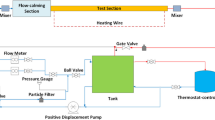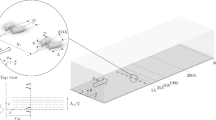Abstract
A comprehensive and systematic, computational investigation is presented on the effect of wall roughness on the supersonic flow over a circular cylinder with a Reynolds number of 500. Flow simulations are conducted using ANSYS Fluent. Wall roughness is modeled by a perturbation of the cylinder geometry with harmonic modes of varying amplitude and frequency. Validated smooth cylinder flow simulations for a range of Mach and Reynolds numbers with slip and no-slip wall serve as a reference. Roughness is shown to increase the effective diameter of the cylinder and the drag by displacing the outer flow along the peaks of the roughness elements. For lower frequencies, this effect is less pronounced than for higher roughness frequencies. While for smooth cylinders the vorticity is mostly generated by viscous shear forces, for rough cylinder the baroclinic vorticity generation is shown to be dominant and shown to determine the topology of the recirculating region.




























Similar content being viewed by others
Data availability
The datasets generated during and/or analyzed during the current study are available from the corresponding author on reasonable request.
References
White, F.M.: Viscous Fluid Flow, 3rd edn. McGraw-Hill, New York (2006)
Farell, C.: Flow around fixed circular cylinders: fluctuating loads. J. Eng. Mech. Div. 107(3), 565–588 (1981). https://doi.org/10.1061/JMCEA3.0002725
Williamson, C.H.K.: Vortex dynamics in the cylinder wake. Annu. Rev. Fluid Mech. 28(1), 477–539 (1996). https://doi.org/10.1146/annurev.fl.28.010196.002401
Loth, E.: Numerical approaches for motion of dispersed particles, droplets and bubbles. Prog. Energy Combust. Sci. 26(3), 161–223 (2000). https://doi.org/10.1016/S0360-1285(99)00013-1
Boiko, V., Kiselev, V., Kiselev, S., Papyrin, A., Poplavski, S., Fomin, V.: Shock wave interaction with a cloud of particles. Shock Waves 7, 275–285 (1997). https://doi.org/10.1007/s001930050082
Sen, O., Davis, S., Jacobs, G., Udaykumar, H.: Evaluation of convergence behavior of metamodeling techniques for bridging scales in multi-scale multimaterial simulation. J. Comput. Phys. 294, 585–604 (2015). https://doi.org/10.1016/j.jcp.2015.03.043
Sen, O., Gaul, N., Choi, K., Jacobs, G., Udaykumar, H.: Evaluation of multifidelity surrogate modeling techniques to construct closure laws for drag in shock-particle interactions. J. Comput. Phys. 371, 434–451 (2018). https://doi.org/10.1016/j.jcp.2018.05.039
Chapman, D.R., Kuehn, D.M., Larson, H.K.: Investigation of separated flows in supersonic and subsonic streams with emphasis on the effect of transition. National Advisory Committee for Aeronautics. Tech. Rep. 1356 (1958)
Tewfik, O., Giedt, W.: Heat transfer, recovery factor, and pressure distributions around a circular cylinder, normal to a supersonic rarefied-air stream. J. Aerospace Sci. 27(10), 721–729 (1960). https://doi.org/10.2514/8.8737
McCarthy Jr, J.F., Kubota, T.: A study of wakes behind a circular cylinder at M equal 5.7. AIAA J. 2(4), 629–636 (1964). https://doi.org/10.2514/3.2399
Reeves, B.L., Lees, L.: Theory of laminar near wake of blunt bodies in hypersonic flow. AIAA J. 3(11), 2061–2074 (1965). https://doi.org/10.2514/3.3316
Grange, J.M., Klineberg, J.M., Lees, L.: Laminar boundary-layer separation and near-wake flow for a smooth blunt body at supersonic and hypersonic speeds. AIAA J. 5(6), 1089–1096 (1967). https://doi.org/10.2514/3.4142
Bashkin, V., Egorov, I., Egorova, M., Ivanov, D.: Initiation and development of separated flow behind a circular cylinder in a supersonic stream. Fluid Dyn. 33(6), 833–841 (1998). https://doi.org/10.1007/BF02698651
Bashkin, V., Vaganov, A., Egorov, I., Ivanov, D., Ignatova, G.: Comparison of calculated and experimental data on supersonic flow past a circular cylinder. Fluid Dyn. 37(3), 473–483 (2002). https://doi.org/10.1023/A:1019675027402
Schmidt, B., Shepherd, J.: Oscillations in cylinder wakes at Mach 4. J. Fluid Mech. 785(R3), 1–8 (2015). https://doi.org/10.1017/jfm.2015.668
Hinman, W.S., Johansen, C.T.: Interaction theory of hypersonic laminar near-wake flow behind an adiabatic circular cylinder. Shock Waves 26, 717–727 (2016). https://doi.org/10.1007/s00193-015-0615-y
Hinman, W.S., Johansen, C.T.: Rapid prediction of hypersonic blunt body flows for parametric design studies. Aerosp. Sci. Technol. 58, 48–59 (2016). https://doi.org/10.1016/j.ast.2016.08.007
Hinman, W.S., Johansen, C.T.: Mechanisms in the hypersonic laminar near wake of a blunt body. J. Fluid Mech. 839, 33–75 (2018). https://doi.org/10.1017/jfm.2017.902
Hinman, W.S., Johansen, C.T.: Reynolds and Mach number dependence of hypersonic blunt body laminar near wakes. AIAA J. 55(2), 500–508 (2017). https://doi.org/10.2514/1.J055220
Güven, O., Farell, C., Patel, V.: Surface-roughness effects on the mean flow past circular cylinders. J. Fluid Mech. 98(4), 673–701 (1980). https://doi.org/10.1017/S0022112080000341
Achenbach, E., Heinecke, E.: On vortex shedding from smooth and rough cylinders in the range of Reynolds numbers \(6\times 10^3\) to \(5\times 10^6\). J. Fluid Mech. 109, 239–251 (1981). https://doi.org/10.1017/S002211208100102X
Schneider, S.P.: Summary of hypersonic boundary-layer transition experiments on blunt bodies with roughness. J. Spacecr. Rockets 45(6), 1090–1105 (2008). https://doi.org/10.2514/1.37431
ANSYS: 15.0. ANSYS Fluent theory guide (2013)
Anderson Jr, J.D.: Hypersonic and High-Temperature Gas Dynamics. American Institute of Aeronautics and Astronautics (2006)
NIST-JANAF thermochemical tables. https://janaf.nist.gov (accessed: 10 November 2021)
Kadoya, K., Matsunaga, N., Nagashima, A.: Viscosity and thermal conductivity of dry air in the gaseous phase. J. Phys. Chem. Ref. Data 14(4), 947–970 (1985). https://doi.org/10.1063/1.555744
Verigin, M., Slavin, J., Szabo, A., Gombosi, T., Kotova, G., Plochova, O., Szegö, K., Tátrallyay, M., Kabin, K., Shugaev, F.: Planetary bow shocks: gasdynamic analytic approach. J. Geophys. Res. Space Phys. 108(A8, 1323) (2003). https://doi.org/10.1029/2002JA009711
Grasso, F., Pettinelli, C.: Analysis of laminar near-wake hypersonic flows. J. Spacecr. Rockets 32(6), 970–980 (1995). https://doi.org/10.2514/3.26717
Biswas, S., Kalita, J.C.: HOC simulation of Moffatt eddies and its flow topology in the triangular cavity flow. arXiv (2017). https://doi.org/10.48550/ARXIV.1710.06251
Anderson, J.D.: Modern Compressible Flow: With Historical Perspective. Tata McGraw-Hill Education, New York (2003)
Acknowledgements
The authors acknowledge funding provided by a mobility grant from Spain, and funding from AFOSR under Grant No. FA9550-19-1-0387 is greatly appreciated.
Author information
Authors and Affiliations
Corresponding author
Ethics declarations
Conflict of interest
The authors declare that they have no conflict of interest.
Additional information
Communicated by A. Hadjadj.
Publisher's Note
Springer Nature remains neutral with regard to jurisdictional claims in published maps and institutional affiliations.
Appendix
Appendix
1.1 Specific heat coefficients
\(C_P /R = a_1 + a_2 T + a_3 T^2 + a_4 T^3 + a_5 T^4\), where R is the universal gas constant for air that is 287 J/(kg K) for air [25].
1.2 Thermal conductivity
Thermal conductivity obtained with the Eucken method given a constant \(\gamma \), and the thermal conductivity of dry air at two different pressures from Ref. [26]
Rights and permissions
Springer Nature or its licensor holds exclusive rights to this article under a publishing agreement with the author(s) or other rightsholder(s); author self-archiving of the accepted manuscript version of this article is solely governed by the terms of such publishing agreement and applicable law.
About this article
Cite this article
Blanco-Casares, A., Jacobs, G.B. Wall roughness effects on the supersonic flow over a circular cylinder. Shock Waves 32, 643–663 (2022). https://doi.org/10.1007/s00193-022-01098-y
Received:
Accepted:
Published:
Issue Date:
DOI: https://doi.org/10.1007/s00193-022-01098-y





